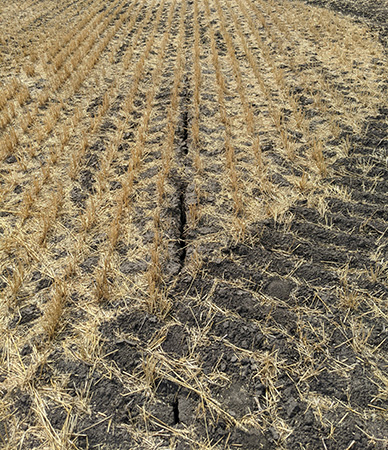The 2021 growing season has been one to be remembered in northwest Minnesota. Most of the region started the year with abnormally dry conditions that escalated to exceptional and extreme drought (the U.S. drought monitor’s worst drought categories) by mid-summer.
Some effects of this drought, like stunted crop development and a lack of water running through drainage ditches, are easy to see in farmer’s fields throughout the region. The impact of the drought on agricultural research at the Northwest Research and Outreach Center is more varied.
Thinking differently about water
Lindsay Pease, CFANS Assistant Professor and Extension Nutrient & Water Management Specialist, has a large drainage study in place. In a year with such little rain, it’s hard to study drainage.
“We’ve had to shift how we’re thinking about looking at water in the plot,” Pease explains. “We’re focusing a lot more on soil moisture and getting a picture of how that’s looking in the root zone.”
During the month of August, Crookston had a few sporadic larger rains of 1.02” and 0.5”. While these precipitation events weren’t anywhere near large enough to generate drain flow, they did allow Pease and her team to see some moisture in the root zone and see how water moves through the soil profile.
Pease notes that one thing has become very clear in looking at the soil profile in such a hot and dry year - the influence of compaction. The heavy clay soils of the Red River Valley have shrunk and become hard and concrete-like. Plant roots can't move through the heavy clay layers, so longer-standing compaction becomes really obvious when there isn’t enough water.
“There are some huge cracks in the soil in our drainage plots, and it’s going to lead to some interesting things to watch water quality wise. If you broadcast fertilizer on top of a crack and get some rain on top of it, it won’t have time to absorb and will instead go straight down to the drainage system. We will watch those drainage systems closely for leeching as we get rains.”
With the frequency of extremely wet and extremely dry years anticipated to increase as Minnesota’s climate changes, Pease sees supplemental water management strategies like irrigation and drainage, or a combination of the two, becoming increasingly important to getting a stable crop every year.
“I’m hoping to integrate irrigation into my research along with the drainage research to look at a systems approach. Controlled drainage with lift stations could be a good strategy for both wet years and times of drought to help hold water in the soil profile.” she notes. “However, these are expensive practices for farmers to implement so they need to know if such large investments will pay off over time.”
Fewer diseases, more insects
Extension Small Grains Specialist Jochum Wiersma notes that the drought made for a “boring” year of research. The hot and dry conditions suppressed diseases typically seen in small grains and made management less intensive for producers.
“There was very little disease pressure this year,” Wiersma explains. “For the last 20 years, I’ve always talked about fungicides. This was the first year of recommending no fungicides.”
The lack of fungal diseases and dry conditions resulted in increased insect pressure in several crops in Minnesota. Ian MacRae, CFANS Professor and Extension Entomologist, says the hot weather sped up insects’ physiological processes and led to high populations of pests that typically aren’t as much of a concern.
“We didn’t get natural control from fungal diseases this year so we saw high numbers of aphids in small grains, spider mites in soybeans, and grasshopper issues throughout the state,“ MacRae explains.
Wiersma notes that the high aphid populations during grain fill took lots of growers by surprise. “With no need to spray fungicide, fields didn’t get the add-on insecticide treatment with it. There was some worry about yield loss but the aphid populations didn’t reach that threshold.”
Instead, Wiersma attributes the large variations in small grain yields across the state to differences in the previous crop and the amount of rain any given operation got at key times throughout the growing season.
MacRae responded to the high insect populations by turning some of his research plots into residual activity trials. “The insects definitely affected the type of data we collected and how we’re looking at it,” he explains. “We looked at how long the insecticide treatments can last - it’s a worst case scenario kind of thing.”
A record-breaking year
Significant portions of Polk County, where Crookston is located, have been in the U.S. Drought Monitor’s extreme and exceptional drought categories since July 20th. The NWROC weather station recorded 6.18” of precipitation from January 1 to August 31, making it the driest first eight months of a year on record since the station began keeping weather records in 1890.
“This is the worst drought in northwest Minnesota’s history,” comments MacRae. “This year’s crop used up every bit of moisture available. Ideally, we’ll get several inches of rain every week to replenish the water table for next year. If we don’t get some rain we could be in a tight spot next year.”

